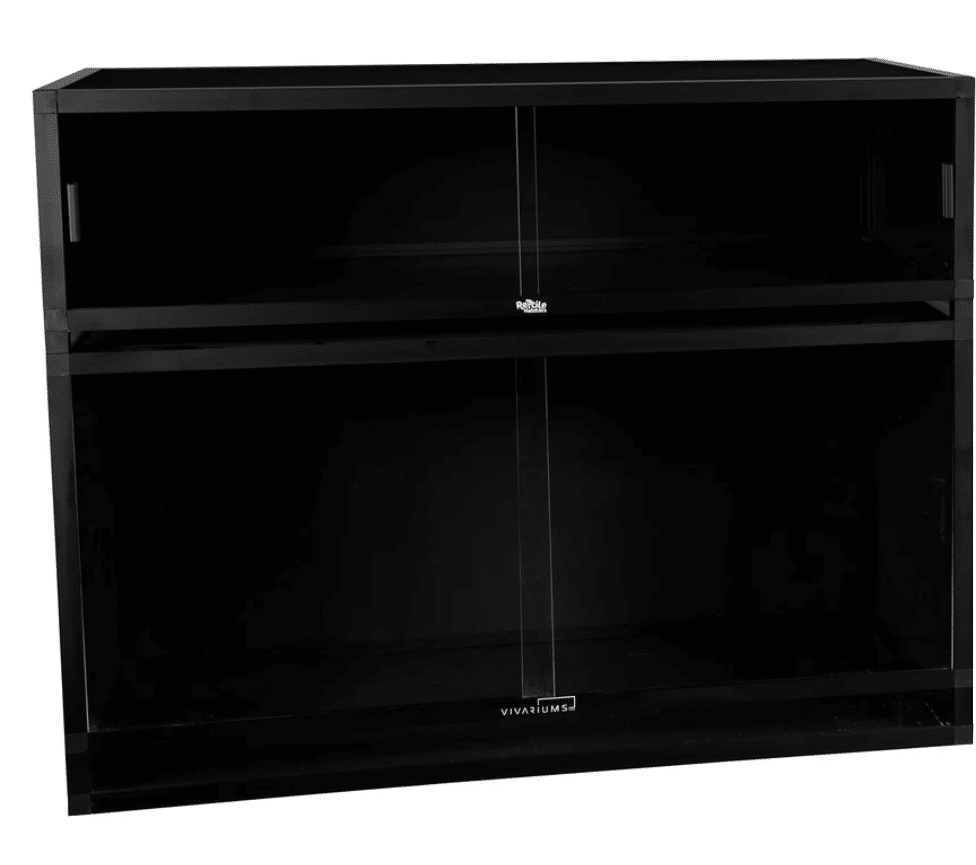The Ultimate Guide for beginners to Owning a cute Leopard Gecko Lizard (with FAQs)

Sharing is Caring!
Introduction
Leopard geckos are captivating creatures that make fantastic small pets for pet lovers of all ages, even teenagers, adolesences or adults, due to their charming appearance and relatively easy care requirements. This ultimate guide will delve into all aspects of owning a pet lizard. From understanding the leopard gecko lifespan and monitoring their health to providing top-notch care, you’ll find valuable insights and practical advice that will help you become a confident and responsible leopard gecko owner.
Overview of these cute leopard geckos
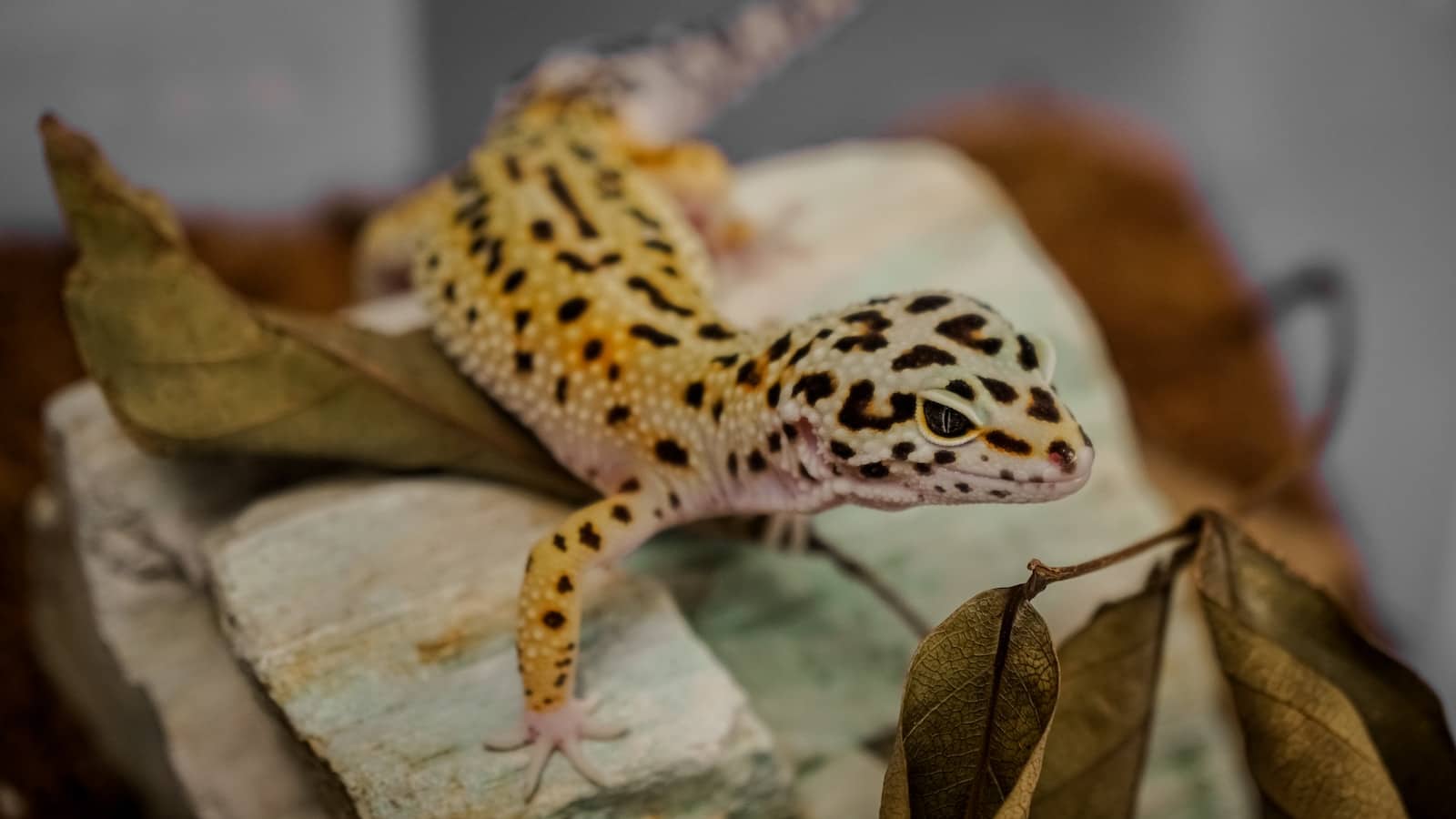
Originating in the dry and semi-desert areas in America, Afghanistan, Iraq, Iran, and northwest India, Leopard Geckos have been imported to mainland America, bred, and tamed to become friendly and adorable pets for over 30 years. Nowadays, Leopard Geckos are among the most popular lizard pets among pet enthusiasts in the U.S.
Leopard Gecko, also known as Common Leopard Gecko, is a colorful and low-maintenance pet, that perfectly suits busy households or families with children. Leopard Gecko usually comes in yellow, hot orange or white with dark spots all over the body, which explain the name of “Leopard Gecko” as it resembles the pattern of a leopard. These spots may turn to stripes in the latter years of the gecko.
These patterns, in combination with the gecko’s colors, the eyes, the tail, and the size, are so unique and distinctive that there are over 50 combos and morphs of Leopard Geckos.
| SCIENTIFIC NAME | Eublepharis macularius |
| WEIGHT | 1.8 to 2.8 ounces |
| LENGTH | from 7.8 inches to 11 inches including tails Male leopard geckos are usually bigger than the female. |
| LIFE EXPECTANCY | up to 20 years |
Understanding your gecko behavior and characteristics
Leopard geckos exhibit a range of intriguing behaviors and characteristics that contribute to their unique charm. As pets, they are a low-maintenance pet which require little attention and care.

These cute lizards are Nocturnal Ground-Dwellers with Docile Nature
Leopard geckos are primarily nocturnal creatures, preferring the cover of darkness to explore and engage in their activities. Unlike some gecko species, they are ground-dwellers, choosing to remain close to the substrate rather than climbing walls. This behavior results in a special biological characteristic in leopard gecko, which is they lack the sticky toe pads characteristic of other geckos or lizards. Thus, it is impossible for a leopard gecko to climb or stick to smooth surface. Insteads, they possess a distinctive feature to adapt with the bumpy rocky terrain – claws and the underground condition – eyelids.
Gentle Disposition and Vocal Expressions
Known for their gentle and slow-moving demeanor, these cute leopard geckos are not prone to biting, making them suitable for those seeking a calm and interactive reptile companion. These geckos are surprisingly vocal, particularly when they are hungry. Emitting chirps and squeaks, they communicate their needs in a unique way, providing an audible glimpse into their world.
Tail Communication and Expressions
Leopard geckos employ their tails as a means of communication, showcasing a variety of movements that convey distinct messages. Using the tail in high frequency to communicate is the reason for featured muscle tails in leopard geckos.
- Tail waving and pointing up
In multi-gecko enclosures, observe for tail-waving—a deliberate, slow, back-and-forth motion often accompanied by raising the tail. This behavior signals a sense of threat, indicating a potential attack. In such cases, swift separation is advisable to prevent conflicts.
- Tail Rattling
Interestingly, leopard geckos exhibit a behavior akin to rattlesnakes—tail rattling. If you witness your cute leopard gecko rapidly vibrating the tip of its tail, it signifies heightened excitement, often triggered by anticipation of a meal or a mating encounter.

Tail Autotomy: A Remarkable Defense Mechanism
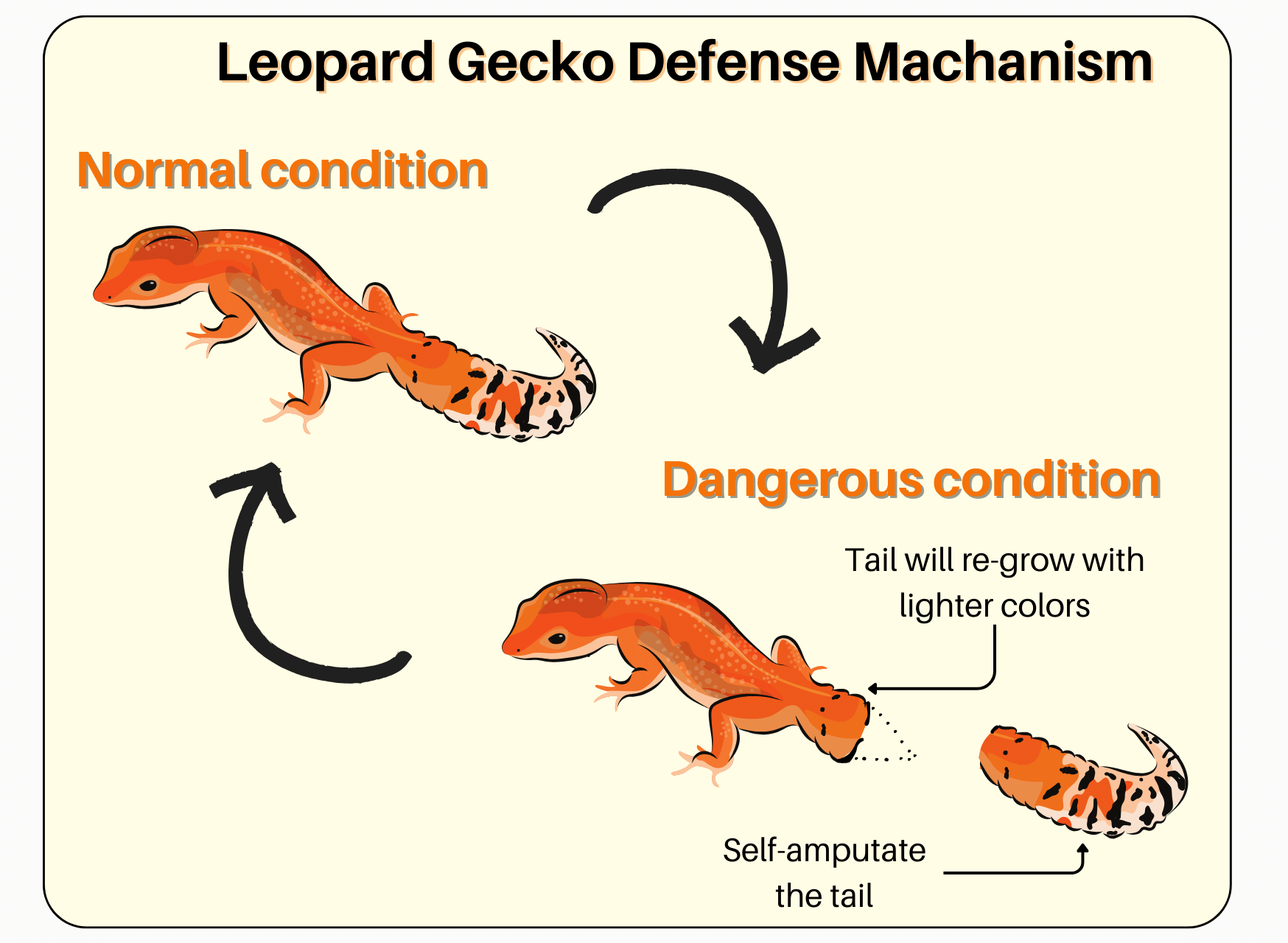
Among their remarkable traits, leopard geckos possess a distinctive skill for warriors, which is self-amputating the tails just like various lizard species. In case of dangers, geckos can dispense the tails, allowing them to escape predators while regenerating a new tail over time.
The Ultimate Guide to Owning a Cute Leopard Gecko Lizard
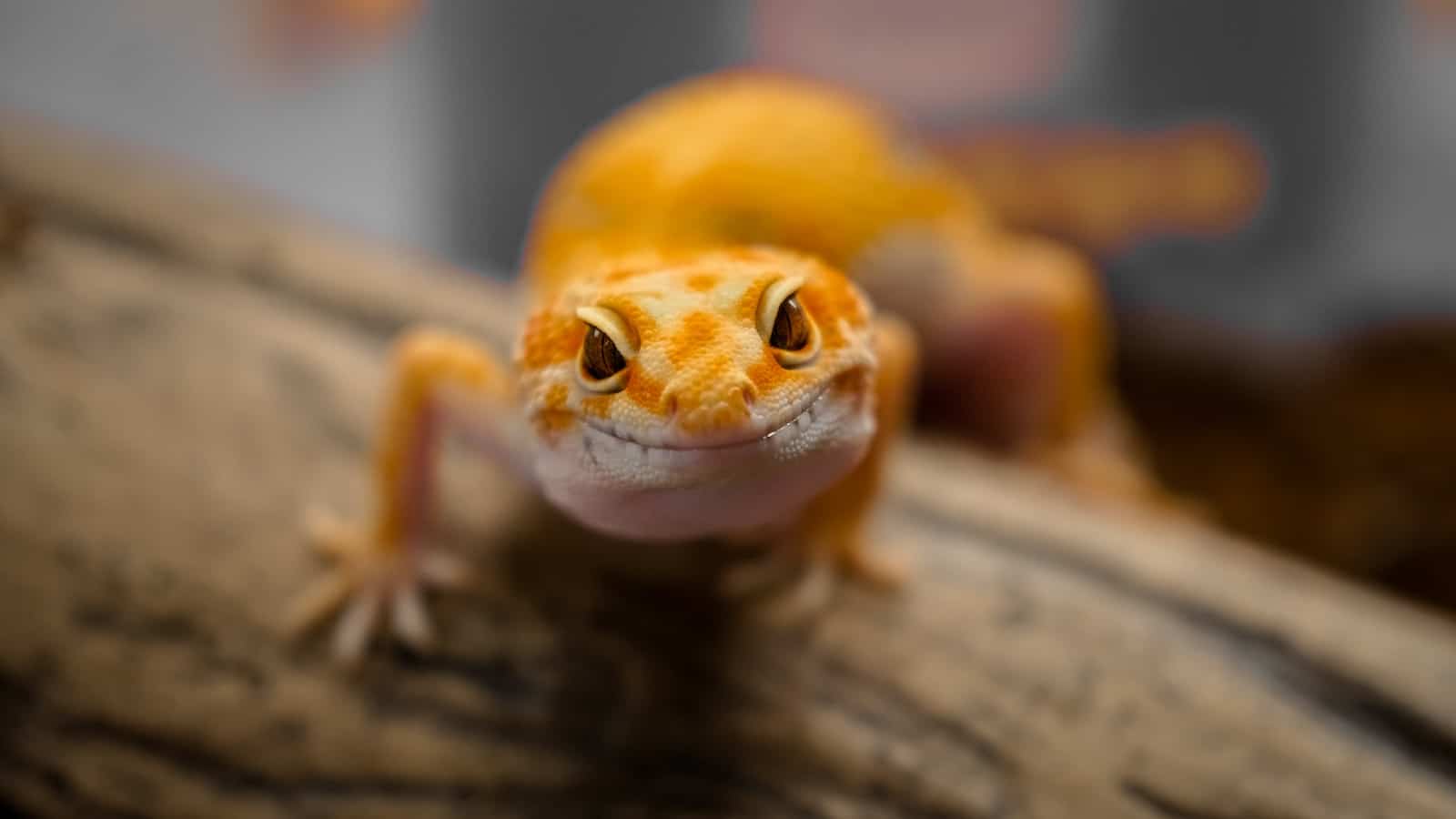
Leopard geckos are renowned for their unique patterns, vibrant colors, and docile nature. As a potential or proud owner, it’s essential to have a complete understanding of their life span, how to monitor their well-being, and how to provide optimal care to ensure they thrive in their habitat.
1. Understanding the Life Span of Leopard Geckos
Contrary to the tiny appearance, these cute leopard gecko lifespan is typically long, ranging from 10 to 20 years with proper care and healthy diet. This trait makes them a long-term commitment for pet owners. Proper care and a suitable environment play a crucial role in determining their longevity. Creating an enriching and comfortable leopard gecko habitat will contribute to their overall well-being and happiness throughout their life.
As a low-maintenance pet, leopard gecko’s owner does not need to worry much but pay attention to the habitat set up with heating and moisturizing notices. The next factors contributing to the longevity are the eating habit and the diet of your gecko. So be careful with the food to make sure it is nutritious and non-toxic to your gecko.
2. Monitoring the Health of Your Cute Leopard Gecko
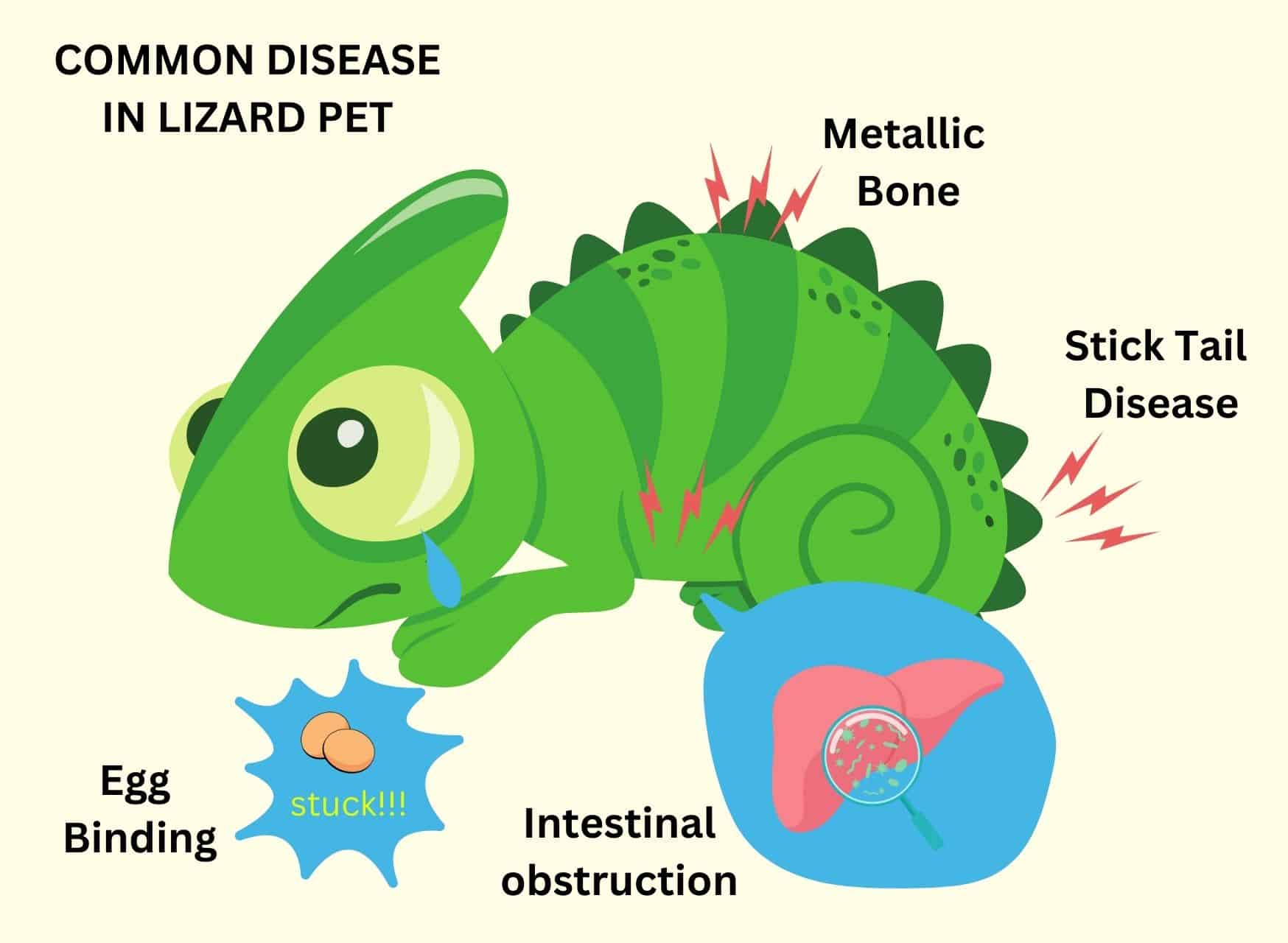
Regular health checks are vital to ensuring the well-being of your cute leopard gecko. If you notice any changes in behavior, appetite, or physical appearance, it’s crucial to consult a veterinarian with experience in reptile care. There are multiple diseases may cause damage to your gecko if the owners are not able to detect the symptoms of these illnesses.
Intestinal obstruction: This condition occurs when Leopard Geckos eat bedding in their cage. They cannot be digested and can lead to death if not treated promptly. If you can not monitor your pet frequently, you should not choose a litter that is too small in size such as sand and sawdust.
Egg Binding: This disease occurs when you do not get enough calcium in your Lizard’s diet. This will prevent the eggs from escaping during the lizard’s breeding time. However, it is more frequent in snakes than lizards.
Metabolic bone (MBD): This problem is very common in reptiles. Occurs when the leopard gecko does not get enough calcium in the diet. This can cause spinal deformities, extremities, and pain for the animal.
Stick tail disease: This disease is most commonly caused by cryptosporidium, a microscopic parasite commonly found in reptiles. Having stick tail, your gecko will lose weight, their tails will shrink and they will stop eating, have diarrhea and become inactive. This disease is contagious and you need to separate them when you detect the disease. To prevent diseases, the process of feeding them needs to be hygienic and clean to ensure safety.
3. Habitat Setup and Maintenance
Leopard Lizards will grow best in a reasonable, well-ventilated environment. Overall, ensure you have a well-ventilated terrarium with a secure lid, appropriate substrate (like reptile carpet or paper towels), hiding spots, and climbing opportunities.
The cage for your gecko can be a plastic box, an old aquarium or a cage. Minimum dimensions are 20 inches long, 10 inches wide and 12-15 inches high for a pair of geckos. The cage should be equipped with a rock cave, tree branches or hollow log for them to climb and hide. Shelters for geckos that contain water, moss and minerals will help them easily shed their skin.
4. Bedding

Bedding should use soil, shredded papers, desert sand, gravel, artificial grass or simply newspaper. One of the best option is using paper for bedding. Although shredded paper does not absorb odors, it is convenient for cleaning. In addition, using paper will prevent your cute leopard geckos from eating by mistake because they think it is food. Paper is also a compostable material so it can be seen as an environmentally-friendly material.
Leopard geckos are local to dry desert areas so utilizing desert sand as a prime floor can also give them a living environment alike to their original nature. Do not use wood as bedding because wood chips can scratch those cute leopard geckos’ tiny foot. However, be careful not to let them go hungry as they can eat sand or gravel to please its starve, causing intestinal blockage.
5. Temperature and Lighting
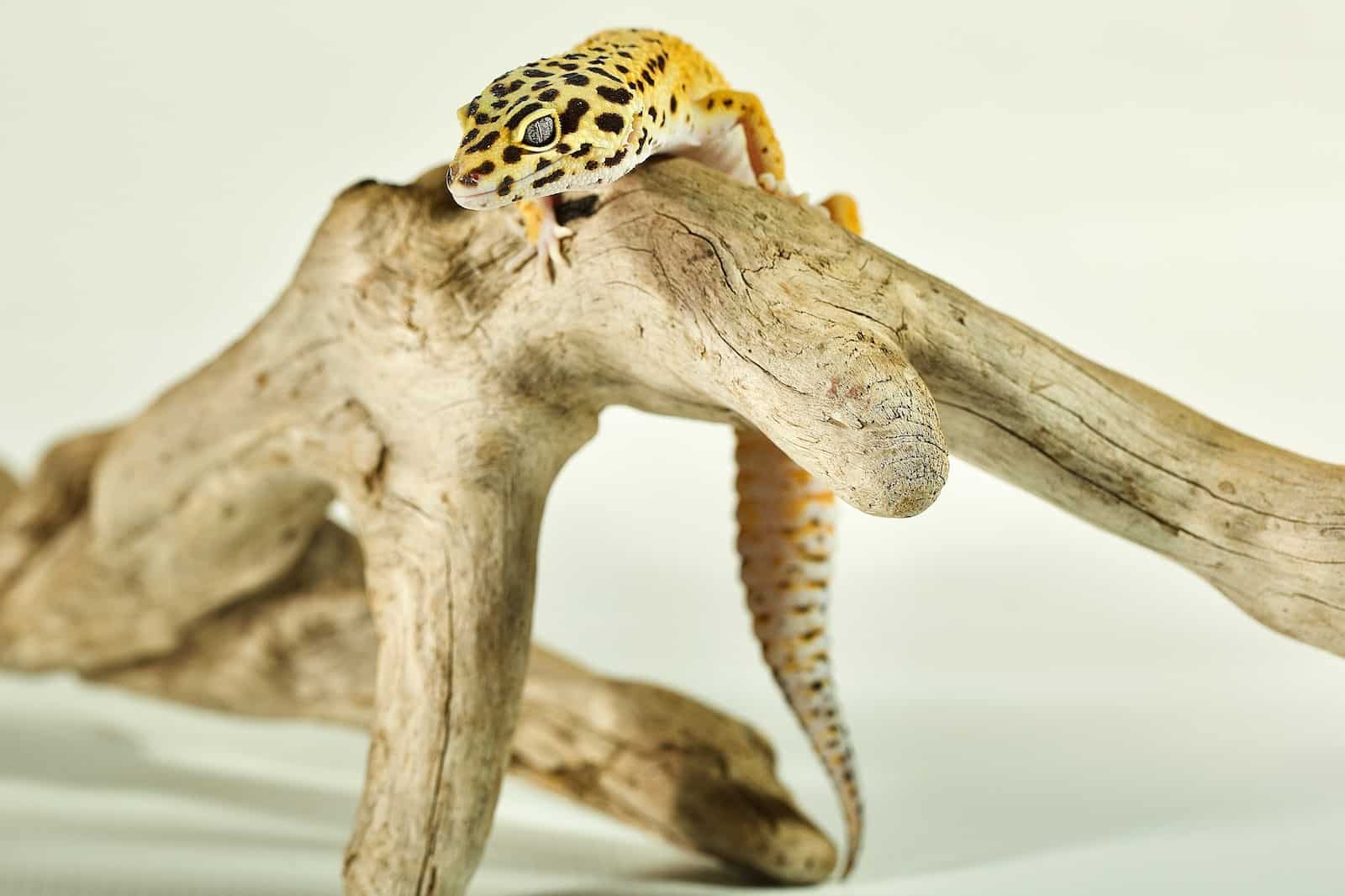
Maintain a temperature gradient with a warm side (around 88-92°F) and a cooler side (around 75-80°F) to allow your gecko to regulate its body temperature. Remind that leopard geckos are nocturnals with docile nature, they do not require UVB light on a whole day. A little UVA and UVB per day can help your geckos avoid metabolic bone diseases. You should take an advice from the vet beforehand.
If needed, automatical lights may be the best solutions for busy owners as they will turn off by time setting or remotely through mobile apps.
6. Hydration
Provide a shallow dish of clean, fresh water at all times. While those cute leopard geckos don’t drink water frequently, having access to water anytime is important for their well-being. Besides, a water tray helps create humidity for the gecko to shed its skin and avoid dysecdysis. Additionally, consider occasional gentle misting to maintain humidity levels.
7. Feeding and Nutrition
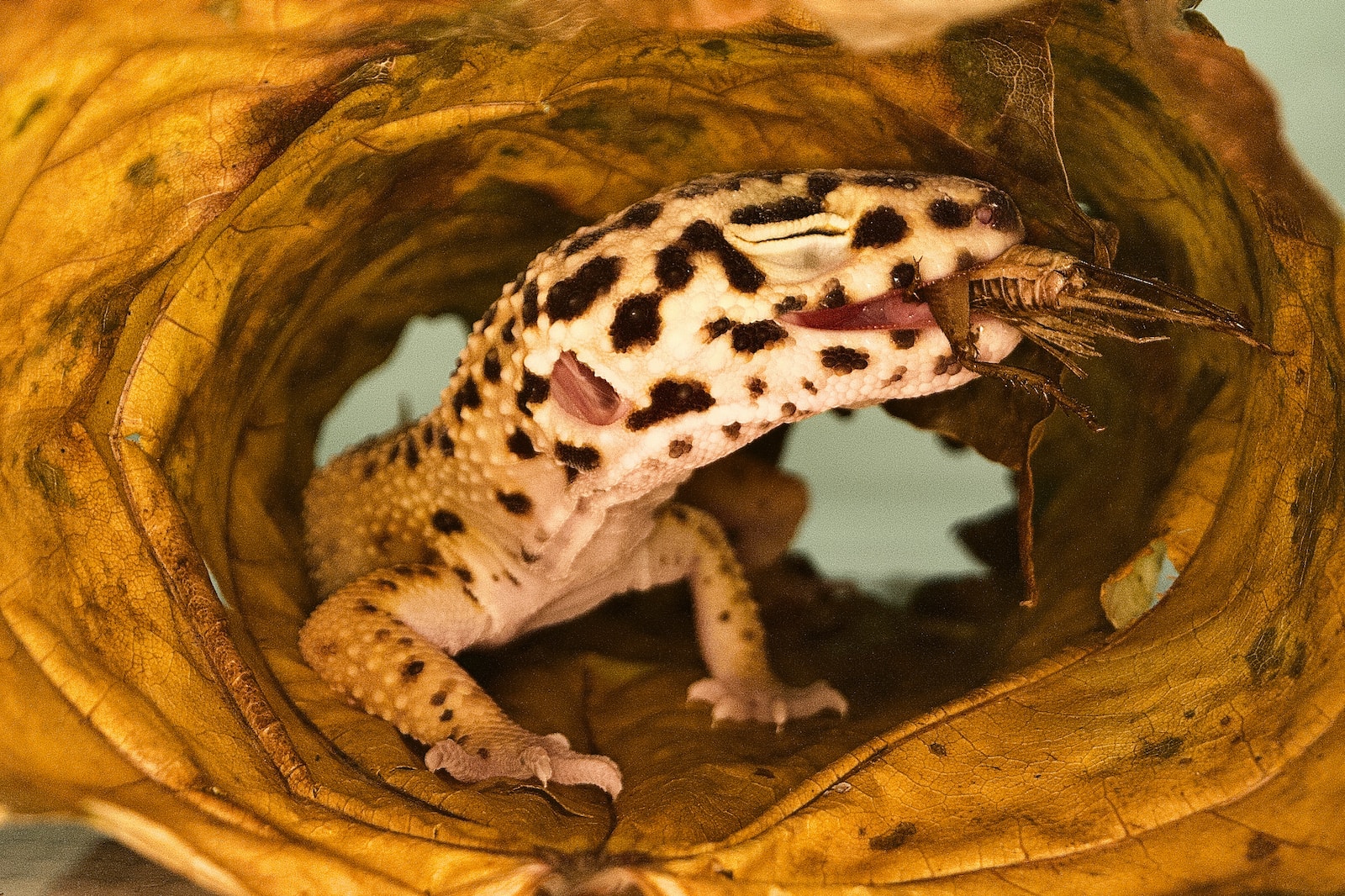
Leopard geckos are insectivores, meaning their diet primarily consists of insects. You can offer appropriately sized prey insects, such as crickets, mealworms, and dubia roaches. In addition, you can provide grain or canned foods specially prepared for geckos.
You must feed all insects a nutritious diet 12-24 hours before feeding the Leopard Gecko lizard. This process is called gut loading because insects often have parasites, worms and tapeworms that are very harmful to your cute Leopard Gecko. Gut loading will provide more nutrition as well as get rid of the harmful parasites in the food. Make sure the food is hygiene to avoid stick tail disease.
In addition, you need to supplement vitamins such as vitamin D3 and powdered calcium during the process of nurturing for bone health of your cute Leopard Gecko. It is adviced to feed juveniles every day, and for adult leopard geckos, it can be every 3-4 days to feed once.
8. Mental care
Leopard geckos can become accustomed to gentle handling over time. Start with short sessions and gradually increase the duration as they become more comfortable. Always handle them with clean hands and avoid gripping their delicate tails, as they may drop their tails as a defense mechanism.
Conclusion
Owning a leopard gecko can be a truly rewarding experience, but it comes with responsibilities. By understanding their life span, monitoring their health, and providing comprehensive care, you can ensure a fulfilling and joyful companionship. Remember, each leopard gecko is unique, so taking the time to learn about their individual needs and behaviors will contribute to a long and harmonious relationship.
Frequently Asked Questions (FAQs)
1. How big do leopard geckos get? Leopard geckos usually reach a length of 8 to 10 inches, with females being slightly smaller than males.
2. How long do Leopard Gecko live? Leopard geckos and other reptiles may have great longevity with proper care, up to 20 years.
3. Can I house multiple leopard geckos together? While leopard geckos are generally solitary creatures, you can house females together if they are introduced properly and the enclosure is spacious enough.
4. How often should I clean the terrarium? Perform a spot clean daily to remove waste, and do a thorough cleaning of the entire enclosure every month to maintain hygiene.
5. What should I do if my cute leopard gecko stops eating? A temporary loss of appetite can be normal, but if it persists for more than a week, consult a veterinarian for advice.
6. Do leopard geckos require UVB lighting? Leopard Lizards are nocturnal, sheltering under rocks or in burrows during the day. They do not have a need for UVB rays like some other reptiles. In facts, heavy UVB may damage the skin of your gecko and result in skin diseases. While leopard geckos don’t necessarily require UVB lighting, providing a low-intensity UVB light following vet’s advice can offer some additional benefits to their health.
7. How do I know when my cute leopard gecko is shedding? Leopard geckos may appear dull and opaque before shedding. They will then emerge with brighter, vibrant skin once the shedding process is complete.
8. Do leopard geckos sleep with eyes closed? Yes, leopard geckos are different from other gecko species, the species in the genus Eublepharidae like leopard geckos have moveable eyelids. Therefore, they usually sleep with eyes shut.
9. Can my cute leopard geckos climb on the wall? The answer is no, these cute leopard geckos lack of toe pads like domestic lizards so it is impossible to stick up to smooth surfaces. However, they can climb up on trees or rocky terrain thanks to the claws.
10. Why my leopard geckos shed their skin? Leopard geckos shed the skin as a biological methods to prevent predators to detect their scent. When your gecko sheds, its skin would become more vivid and appear in neat patterns.
Sharing is Caring!
About The Author
PawCool Team
Related Categories: Reptiles | Geckos | Small Pets
Latest Articles

Never Miss A Thing!
All pet stories & guides you care about

